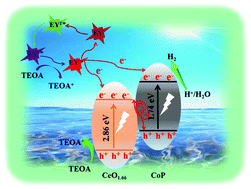Design and synthesis of phosphating bimetallic CeCo-MOF for substantially improved photocatalytic hydrogen evolution
Abstract
Intimate contact between catalysts is one of the effective strategies to improve the migration rate of photogenerated electrons. In this work, bimetallic CeCo-MOF was successfully prepared by a hydrothermal method, and different composite catalysts were obtained from different treatment methods (phosphating, oxidation, and sulfurization). Among them, the composite catalyst obtained from a phosphating treatment exhibited excellent photocatalytic hydrogen evolution activity. The photocatalytic hydrogen evolution performance of the composite catalyst was further optimized by adjusting the content of the Ce source. It was finally determined that when the Ce : Co ratio was 1 : 2, the composite catalyst obtained by phosphating showed a photocatalytic hydrogen evolution rate of 8040.9 μmol g−1 h−1. The excellent photocatalytic performance of CeCo1 : 2/P is mainly attributed to the following three aspects: firstly, the bimetallic CeCo-MOF synthesized using the one-pot thermal method makes the Ce and Co sources uniformly dispersed; Secondly, the light absorption performance of the catalyst can be improved due to the phosphating treatment, which provided the necessary conditions for the massive generation of photogenerated carriers; Third, the close contact between CeO1.66 and CoP ensures the smooth transfer of electrons between catalysts. This work provides new strategies and insights for processing bimetallic MOF materials and their applications in photocatalytic hydrogen evolution.



 Please wait while we load your content...
Please wait while we load your content...